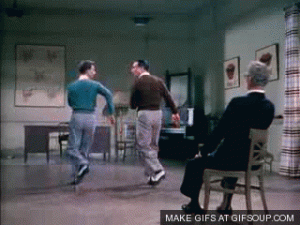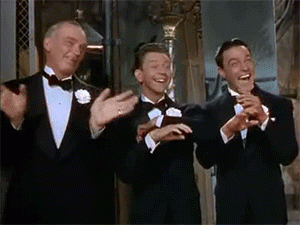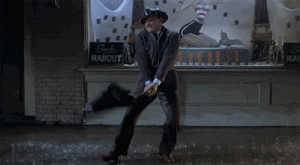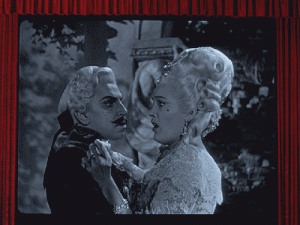Welcome to The Wisdom Daily’s AFI Film Club! Each month, I will be counting down the Top 10 American Film Institute’s list of Motion Pictures (the 2007 update) and exploring an American ideology/ theme in a recap. Why AFI? Why here? Why Now? Why Me? Click here for a brief rant on my connection to the catalog (insert inappropriate “the list is life” joke here). Enjoy the post and comment (about the film please- I already know that I’m terrible at the kazoo). Here is AFI’s #5 Singin in the Rain:
You sure you want to read this?
I’m not being cheeky, I’m dead serious here. Singin’ in the Rain is probably one of the most beloved films of all time. It is filled with tinsel-glee from beginning to end, and as a friend of mine once remarked, does everything a film “should do”. It’s an amusement park for the eye, with stunning baby blue hues sucking the viewer into the dreamlike Hollywood lifestyle. The bubblegum characters are charmingly simple, and they perform marvelous dance numbers atop a shoestring storyline of good feeling and expert vaudevillian technique. I see it as a stylized, performative, 1950’s version of Mamma Mia; it’s an all star cast singing hit songs from years past, aiming to please in every jump click.
This is why I feel I should warn you here, because this film means the world to people, and this critical recap is not going to be a fan page. There are problematic depictions of gender (no duh), and it is as much a product of the Hollywood Blacklist, as it is an homage to The Golden Age. I’m going to stay away from the sentimentality, and pick a few bones with this American classic, so I understand if you don’t want to read it. I doubt my friend will want to either.
If you want to let sleeping dogs lie, then just tune in next month for a very *serious* analysis of Raging Bull.
Please accept these GIFs for your trouble:
Anybody still here?
Alright, let’s jump into The AFI’s fifth- place film, Singin’ In the Rain:
We are thrust into the world of Jazz-age La La Land, where the film studios reign supreme, and the pictures are silent. The biggest stars of the era are Don Lockwood (Gene Kelly) and Lina Lamont (Jean Hagen), who we find going to the premiere of their newest film The Royal Rascal. They play love interests on screen and for the fans, but cannot stand each other IRL.
Lockwood, on his way to the after-party, is ambushed by a gaggle of giggling admirers, and jumps into sweet midwestern Kathy Selden’s (Debbie Reynolds) car for a safe getaway. Kathy is at first terrified, then starstruck, then awfully offended by Lockwood’s aggressive sexual passes. She sticks her nose up at his cheesy and exaggerated film acting, and shares her dreams of stardom on the stage.
Little do they know, but cinema and stage are about to change forever, as silent pictures become a thing of the past with the revolutionary “talkie,” The Jazz Singer. Now Lockwood and Lamont’s studio, Monumental Pictures, wants to make every film with sound, which is great news for Don’s childhood chum and musician, Cosmo Brown (Donald O’Connor), but a harsh wakeup call for the shrill Lina.
Lockwood and Lemont’s The Dueling Cavalier becomes the musical The Dancing Cavalier, and the crew decide that Kathy Selden should serve as Lina’s voice double. At this point, Kathy and Don are dating (they fell in love quickly during a Monumental Pictures lot tour). Kathy agrees, partially to further her career (studio-exec R.F. Simpson promised the next picture will be hers), and partially to make her man happy. Lina gets wind of this deal, and threatens to sue if she doesn’t get control over Kathy’s career, which would doom Selden to the life of a ghost singer. Worse yet, Lina is even getting ideas, thinking of taking over the network and renaming it Lemont Pictures. That can absolutely not happen, so Don and Cosmo think of a plan to expose the true singer behind Lina’s melodic voice. It works, the crowd goes wild, and Selden and Lockwood make movies ever after.
If, for no other reason, Singin’ In the Rain earns its place on the list by its extraordinarily talented ensemble cast, (perhaps its only rivals being The Godfather Part II and Casablanca). Gene Kelly is a revelation, and is almost superhuman when he dances, never seeming like he actually touches the ground. Every dance number, no matter how randomly placed in the plot, is an absolute delight. Donald O’Connor’s comic timing is almost a science, reclaiming and reinventing the thrill of slapstick in the song “Make ‘Em Laugh”. First-time performer Debbie Reynolds is perfectly lovely, and Jean Hagen plays the funny voice well. If you squint hard enough, you’ll notice that the squealing Zelda Fitzgerald look-alike is played by future Hollywood royalty, Rita Moreno. This is truly its bottled lightening, something that even the finest actors in copycat films cannot capture.
As I’ve demonstrated in my past articles, for better or for worse, I can tolerate some antiquated views of gender and race for the excuse that it is “of its time.” Peculiarly, in this case, I have trouble divorcing my post-modern feminist views from what seems to be one of the major plot points: a women tries to take autonomy of her career, and her male co-workers seek to bring her down.
Lina Lamont is depicted as a greedy, “urban” (more on the New York Accent below), dummy, who suffers the butt of many jokes. Her ambition is seen as unbecoming, and her “evil plan” to take control of the studio and maintain credit over its work, is something to root against. Conversely, Kathy Seldon is the everywoman, the girlfriend who turns down Don’s advances, but ultimately falls hard for the dashing guy wearing concealer. Her intelligence is not questioned, because she always defers to Lockwood and Brown; she knows her place.
The most rewarding laugh in the film is Lina’s dramatic reveal, with her career destroyed, and any hope of creating and making her own films gone. This fictional plot reflects reality as the real Monumental Pictures, studios like MGM, RKO, Paramount, did try to squander the career of ambitious women like Joan Crawford, Judy Garland, and Bette Davis. While this film can’t be fully faulted for carrying the assumptions of its time, this aspect of the film only further aggravates the pain and injustice of the era.
In 1950, though, Lina needs to be the bad guy. She represents more than just a nasally- pitched actor, but a division between what Hollywood was previously associated with, and what it is trying to be, in the midst of the Blacklist-era. The film industry has a long and complicated relationship with morality clauses. During its inception in the 1910s and 1920s, Tinseltown was a place for many creative, vaudevillian, almost counter-culture individuals; extra-marital affairs ran rampant, same-sex relationships were not uncommon, and drug use was rampant (all things are not created equal). This did not sit well with the media and the federal government, and soon the Hays code was instilled, and Hollywood cinema and actors had to maintain a certain reputation.
That’s when a complete rebranding began, and Hollywood turned their leading men and women from fringe weirdos to American heroes. This kicked off the Golden Age, and the great American musical, and this is what Singin’ In The Rain is nostalgic for.
After WWII, in the early moments of the Red Scare, Hollywood had another crisis of “morality”. House Un-American Activities Committee started crunching down on the supposed communists in Tinsel-town, destroying the careers of supposed enemies of the state, which read more closely as immigrants and liberal Jewish screenwriters and directors. The Dancing Cavalier, the movie within the movie, seems to be the film’s way of separating Hollywood from the ideas of the communist-racial and ethnic prejudice.
In Cavalier, a young star (played by Lockwood played by Kelly) has dreams of Broadway. It shows the fickleness of the Hollywood look and even some of the licentiousness, dictated by a greedy, scar-faced man with an ambiguously ethnic background trying to abuse the system. Lockwood ultimately rejects this way of life, and seems to leave the NY way of life, only to influence and “save” a young hopeful on the way out. Both the scar-faced man and Lina are representative of a xenophobic fear of New York’s corruption, and are used as a foil to Hollywood’s unquestionably down-right “Americanness”. In this depiction, I see the film choosing a side during these dark times, and not only abandoning its artistic integrity, but its loyalty to victims in its community.
Even in my cynicism, I will admit, I can’t help but buy into the world Singin’ In The Rain presents. Regardless of what I know to be true intellectually, I want to believe that a good American movie could save the world. I look to it to be a cultural life preserver made of mirrors, both rescuing us from our daily drudgery, and teaching us what should be a universal truth. Every year, movies like this one come out, and almost every year I hate them and sneer at their simplicity, but quietly feel secure in the falsehoods they present.
Thanks for reading! Tune in for next month’s recap of AFI’s #4 spot, Raging Bull.
Sources:
“NPR Choice Page”. Npr.Org, 2018. Accessed 17 Aug 2018.
Royle, Alan. “DRUGS IN THE SILENT ERA PT 1. ? Historian Alan Royle”. Historian Alan Royle, 2018. Accessed 17 Aug 2018.

Rachel Olshin is a production assistant, TV elitist, mason jar frequenter, “Gerwy”, and member of the Teaneck Public Library. If asked how’d she spend an ideal day, she’d say helping humanity and running on the beach, but really, she’d prefer watching Heathers on loop and consuming large amounts of mac n cheese.





